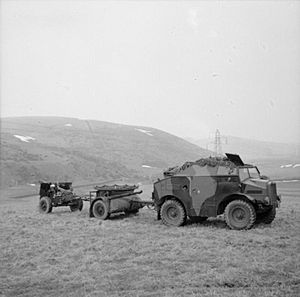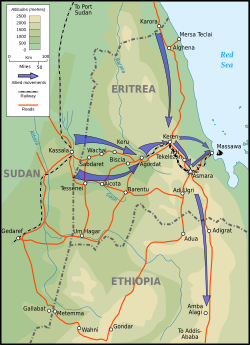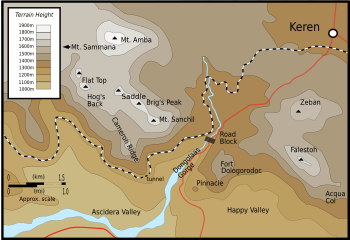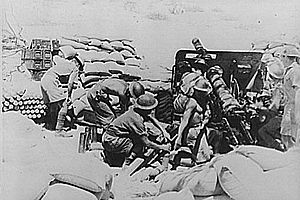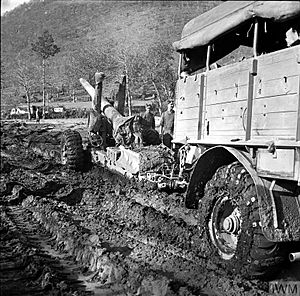Sussex Yeomanry facts for kids
Quick facts for kids Sussex Yeomanry |
|
|---|---|
| Active | 23 June 1794–1828 28 March 1831–1848 14 June 1901 – present |
| Country | |
| Branch | |
| Type | Yeomanry |
| Role | Cavalry Artillery Engineers |
| Size | Regiment |
| Garrison/HQ | Brighton |
| Engagements |
|
| Commanders | |
| Notable commanders |
George Wyndham, 3rd Earl of Egremont Charles Wyndham, 3rd Baron Leconfield Charles Gordon-Lennox, 8th Duke of Richmond |
The Sussex Yeomanry is a special army unit from Sussex, England. It started way back in 1794! This group of soldiers, called a yeomanry regiment, was first created when there was a big worry that France might invade Britain during the Napoleonic Wars.
Over the years, the Sussex Yeomanry played important roles in many conflicts. They fought in the Second Boer War, the First World War, and the Second World War. During the Second World War, they saw action in places like the East African Campaign and the tough Siege of Tobruk. Today, their history and traditions are carried on by a modern army unit called 1 (Sussex Yeomanry) Field Troop, which is part of the Royal Engineers.
Contents
- Early Days: Fighting French Threats
- The 19th Century: Changes and New Beginnings
- The Second Boer War: Imperial Yeomanry
- Territorial Force: Preparing for War
- First World War: Fighting Overseas
- Between the World Wars: A New Role
- Second World War: Global Conflicts
- After the Wars: Modern Changes
- Uniforms and Badges
- Honorary Colonels
- Memorials
- Museum
- See also
Early Days: Fighting French Threats
Britain got involved in the French Revolutionary Wars in 1794. To protect the country, the Prime Minister, William Pitt the Younger, suggested that each county should create its own volunteer cavalry force. These forces were called "Volunteer Yeoman Cavalry" or simply "Yeomanry". They could be called upon by the King to defend against invaders or by local leaders to help with any civil unrest.
By the end of 1794, many counties had formed Yeomanry units, including Sussex. The Sussex Troops of Gentlemen and Yeomen Cavalry started on June 23, 1794. It had four groups of soldiers, with its main base at Petworth House. George Wyndham, 3rd Earl of Egremont, led this new force.
Some of the first groups included:
- Petworth Cavalry
- Henfield Cavalry
- West Hoathly Cavalry
- Forest Row Cavalry
Soon, more groups joined, like the Hastings Cavalry and Rye Cavalry. A special artillery group, the Duke of Richmond's Light Horse Artillery, was also formed in 1797. This group used unique gun carriages designed by Charles Lennox, 3rd Duke of Richmond, which were pulled by four horses.
After a short period of peace, war with France started again in 1803. The Sussex Yeomanry Cavalry quickly reformed. They added new groups, including the Firle Cavalry and the Ringmer Cavalry.
The 19th Century: Changes and New Beginnings
After the wars with France ended, the Yeomanry became less important. By 1817, only a few of the original Sussex groups remained. Most of the Sussex Yeomanry units were officially disbanded in 1828 when the government stopped supporting them.
However, a wave of public unrest across Britain in the 1830s led to the Yeomanry being brought back. The Petworth Troop reformed in 1831, and the Sussex Yeomanry Cavalry was re-established as a full regiment that same year. Its headquarters was in Arundel.
The Second Boer War: Imperial Yeomanry
In 1899, Britain faced difficulties in the Second Boer War in South Africa. The government realized it needed more soldiers than just the regular army. So, on December 24, 1899, they created the Imperial Yeomanry (IY). This new force was made up of volunteers, often from middle and upper-class families. They were trained to fight as soldiers on horseback.
The 69th (Sussex) Company, Imperial Yeomanry, arrived in South Africa in April 1900. They served bravely in various battles.
On June 14, 1901, a new regiment called the Sussex Imperial Yeomanry was approved. It was led by Lt-Col Charles Wyndham, 3rd Baron Leconfield. Soldiers who had returned from the 69th (Sussex) Company helped train the new regiment.
The regiment had its main base in Brighton and included several squadrons (smaller groups of cavalry):
- A Squadron at Hove
- B Squadron at Lewes
- C Squadron at Chichester
- D Squadron at Hastings and Rye (later Eastbourne)
By May 1902, the regiment had 413 soldiers and held its first training camp in Lewes.
Territorial Force: Preparing for War
In 1908, the Imperial Yeomanry became part of the new Territorial Force (TF). The Sussex Yeomanry (TF) was organized with its main base at the Drill Hall in Church Street, Brighton.
Its squadrons were spread out across Sussex:
- A Squadron in Brighton, with smaller groups in Horsham and Worthing.
- B Squadron in Lewes, with groups in Burgess Hill and Uckfield.
- C Squadron in Chichester, with a group in Bognor.
- D Squadron in Eastbourne, with groups in St Leonards and Rye.
The Sussex Yeomanry was part of the TF's South Eastern Mounted Brigade.
First World War: Fighting Overseas
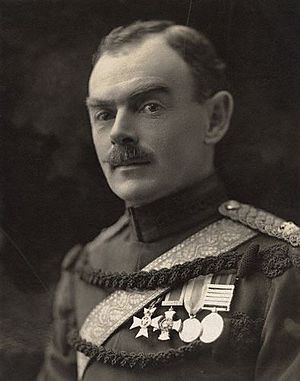
When the First World War began on August 4, 1914, the Sussex Yeomanry was called into action. It was led by Lt-Col Charles Gordon-Lennox, Earl of March. Even though the Territorial Force was originally for home defense, many soldiers volunteered to serve overseas.
To handle this, new "2nd Line" and "3rd Line" units were created. These units trained replacements for the soldiers fighting abroad.
1/1st Sussex Yeomanry: From Gallipoli to France
The main unit, the 1/1st Sussex Yeomanry, first went to Canterbury. In September 1915, they traveled to Liverpool and boarded a ship, the RMS Olympic. They arrived at Lemnos and then landed in Gallipoli on October 8. They joined the 42nd (East Lancashire) Division. Life in Gallipoli was very tough, with many soldiers getting sick. By December, they were evacuated to Mudros.
In February 1916, the regiment moved to Egypt to help defend the Suez Canal. In January 1917, the 1/1st Sussex Yeomanry changed its role. It became an infantry (foot soldier) unit and was renamed the 16th (Sussex Yeomanry) Battalion, Royal Sussex Regiment.
This battalion then joined the new 74th (Yeomanry) Division. With this division, they took part in the invasion of Palestine in 1917 and 1918. They fought in the Second and Third Battles of Gaza, which included capturing Beersheba and Jerusalem.
In April 1918, the division moved to France. The soldiers trained for fighting on the Western Front, learning about things like gas defence. In July 1918, they entered the front lines. From September 1918, they took part in the Hundred Days Offensive, which included the Second Battle of the Somme. By the end of the war, they were near Tournai, Belgium. The unit was officially disbanded in July 1919.
2/1st Sussex Yeomanry: Home Defense and Cyclists
The 2nd Line regiment was formed in Brighton in September 1914. It stayed in England, moving to places like Maresfield and Canterbury. In July 1916, this regiment changed again. It became a cyclist unit, meaning soldiers used bicycles instead of horses. It was part of the 5th Cyclist Brigade.
In November 1916, it merged with another unit to form the 8th (Surrey and Sussex) Yeomanry Cyclist Regiment. However, in March 1917, it went back to being the 2/1st Sussex Yeomanry. In April 1918, the regiment moved to Dublin, Ireland, where it remained until the end of the war.
3/1st Sussex Yeomanry: Training Replacements
The 3rd Line regiment was formed in July 1915 in Brighton. Its main job was to train new soldiers and provide replacements for the 1st and 2nd Line regiments fighting overseas. This regiment was disbanded in January 1917. Its soldiers either joined the 2nd Line regiment or other units.
Between the World Wars: A New Role
After the First World War, the Territorial Force was reorganized into the Territorial Army (TA). Many Yeomanry regiments, including the Sussex Yeomanry, changed from being cavalry (horse soldiers) to artillery (soldiers who operate big guns).
In 1920, the regiment became the 13th (Sussex Yeomanry) Army Brigade, Royal Field Artillery. This was later renamed the 98th (Sussex Yeomanry) Brigade, RFA. In 1922, it joined with parts of the Surrey Yeomanry to form the 98th (Surrey and Sussex Yeomanry) Brigade, Royal Field Artillery. Its headquarters moved to Clapham Park.
In 1939, as another war approached, the TA grew bigger. The Sussex Yeomanry batteries left to form a new regiment called 144th Field Regiment, RA, based in Brighton. Both regiments were known as 'Surrey & Sussex Yeomanry'.
Second World War: Global Conflicts
98th Field Regiment (Surrey & Sussex Yeomanry Queen Mary's)
When the Second World War started in 1939, this regiment was part of the British Expeditionary Force (B.E.F.) sent to France. In May 1940, during the German advance, their guns and vehicles were stuck and had to be destroyed. The soldiers then walked to Dunkirk for evacuation back to the UK.
After reforming in the UK, the regiment went to the Middle East in September 1942. They joined the 10th Armoured Division in Egypt and fought in the famous Second Battle of El Alamein. Later, they served with the 8th Army in Sicily and Italy, including the tough Battle of Monte Cassino. In March 1945, they moved to France and Belgium, ending the war in the Netherlands. The regiment was disbanded in June 1946.
144th Field Regiment (Surrey & Sussex Yeomanry Queen Mary's)
Home Defense and Training
This regiment mobilized in Brighton in September 1939. Initially, they had older guns, but soon received modern 25-pounder guns and Quad tractors. By June 1940, after the Dunkirk evacuation, the 144th Field Regiment was one of the few units in the UK with a full set of these powerful new guns.
East Africa Campaign
After Italy joined the war in 1940, the 144th Field Regiment was sent to Egypt to protect British bases. They landed at Suez in November and joined the 5th Indian Division in Sudan.
In January 1941, the British forces advanced into Eritrea. One of their batteries, 390 Bty, was part of 'Gazelle Force'. On January 21, 1941, D and F Troops of 390 Bty faced a charge by about 60 Eritrean cavalry. This was likely one of the last times British forces faced a cavalry charge! The gunners used their guns and rifles to drive them off.
They then fought in the three-day battle for Agordat. After that, they reached the main Italian defenses at Dongolass Gorge, leading to the eight-week Battle of Keren. This was a very difficult battle fought in steep mountains. The regiment's artillery played a key role, firing thousands of rounds to support the infantry.
On March 25, 398 Bty successfully stopped enemy tanks. Keren fell two days later. The regiment then helped in the final push on Addis Ababa, and the main Italian force in East Africa surrendered in May 1941.
Siege of Tobruk
After the East Africa campaign, the 144th Field Regiment returned to Egypt. In September 1941, its soldiers were shipped into the besieged port of Tobruk in Libya. They replaced the Australian soldiers who had been defending the port during the siege.
At Tobruk, they took over a mix of old guns, which their commanding officer called "the most extraordinary collection of junk." On November 21, the 70th Division began its breakout from Tobruk to link up with the Eighth Army. The 144th Field Regiment's observers helped direct their guns to hit enemy positions. After tough fighting, the link-up was achieved on December 5.
In January 1942, the regiment received new 25-pounder guns. They then helped defend the Gazala Line during a break in the fighting.
Middle East and End of War
In May 1942, the 144th Field Regiment moved to Iraq and later to Syria and Persia (modern-day Iran). In January 1943, they reorganized their 24 guns into three batteries. They moved to Egypt and then Palestine in 1944. They remained in Palestine, Lebanon, and Syria for the rest of the war, seeing no further action. The regiment was disbanded in September 1945.
74th Medium Regiment
The 74th Medium Regiment was formed in Brighton in January 1940. It was considered a new unit, not directly part of the Yeomanry. Its batteries used large guns like 6-inch howitzers or 60-pounders from the First World War.
The regiment was stationed in South-East England, a critical area for defense against invasion. By 1942, it was ready for mobile warfare. In October 1942, the regiment was assigned to First Army for the landings in North Africa (Operation Torch).
The 74th Medium Regiment served in North Africa and later in the Italian Campaign. They were part of special artillery groups called "Army Groups Royal Artillery" (AGRAs). These groups were powerful artillery brigades that could move quickly to support different parts of the army. They had enough firepower to destroy enemy artillery.
The regiment supported the advance of X Corps after the Germans' "Winter Line" was broken. They continued to fight through Italy, including during Operation Olive to break the Gothic Line. They also played a big role in the final offensive in Italy in 1945. The regiment was disbanded in December 1945.
After the Wars: Modern Changes
When the Territorial Army was reformed in 1947, the Sussex Yeomanry became the 344th (Sussex Yeomanry) Light Anti-Aircraft Regiment, RA. This meant they operated guns designed to shoot down enemy aircraft. In 1950, they merged with another unit, the 605th (Sussex) Heavy Anti-Aircraft Regiment.
In 1955, there were more changes, and the 344th LAA Regiment merged with several other Sussex artillery units to form the 258 (Sussex Yeomanry) Light Anti-Aircraft Regiment, RA. In 1961, this regiment merged again to become the 257 (Sussex Yeomanry) Field Rgt.
In 1967, the Territorial Army became the TAVR. The regiment was reduced in size to the 200th (Sussex Yeomanry) Medium Battery.
In 1993, the 200 (Sussex Yeomanry) Battery changed its role again. It became 127 (Sussex Yeomanry) Field Squadron in the Royal Engineers, which are army engineers. Although the regiment was disbanded in 1999, its history and traditions live on. Today, the lineage is maintained by 2 (Sussex Yeomanry) Troop, part of 101 (London) Engineer Regiment (Explosive Ordnance Disposal) (Volunteers). This unit specializes in dealing with bombs and explosives.
Uniforms and Badges
The early Sussex Yeomanry units in 1794 wore dark green jackets with black trim and white trousers. They also had light cavalry helmets with feather plumes. Later, in 1831, they wore light blue jackets with red trim, similar to Light Dragoons.
When the Sussex Imperial Yeomanry formed in 1901, they wore khaki uniforms. They had bright blue details on their cuffs and collars. Their hats were slouch hats with bright blue emu feathers. In 1909, their formal uniform changed to a bright blue tunic, similar to what the British Army wears today for parades. Officers had special spiked helmets with yellow and blue plumes for important events.
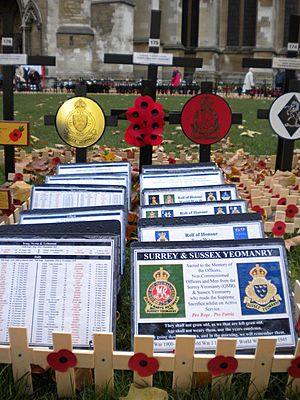
After 1930, the different batteries wore their own Surrey or Sussex Yeomanry cap badges. During the Second World War, both regiments wore special embroidered shoulder titles that said 'SURREY & SUSSEX' over 'YEOMANRY Q.M.R.' in yellow on navy blue. In the Middle East, they used brass shoulder titles. After the war, they kept their unique cap badges and shoulder titles.
Honorary Colonels
An Honorary Colonel is a special ceremonial leader for a military unit. Here are some who served the Sussex Yeomanry:
- William Nevill, 1st Marquess of Abergavenny (appointed 1901)
- St John Brodrick, 1st Earl of Midleton (appointed 1901, joint from 1922)
- Charles Wyndham, 3rd Baron Leconfield (appointed 1922)
Memorials
- A brass plaque honoring eight members of the 69th (Sussex) Company IY who died in the Second Boer War is in St Mary the Virgin Church at Battle.
- Memorial tablets for the regiment's soldiers who died in the First and Second World Wars are in the village of Charlton, near Chichester.
Museum
You can find a small collection of items related to the Surrey and Sussex Yeomanry at Newhaven Fort.
See also
- Imperial Yeomanry
- List of Yeomanry Regiments 1908
- Yeomanry
- Yeomanry order of precedence
- British yeomanry during the First World War
- Second line yeomanry regiments of the British Army
- List of British Army Yeomanry Regiments converted to Royal Artillery


